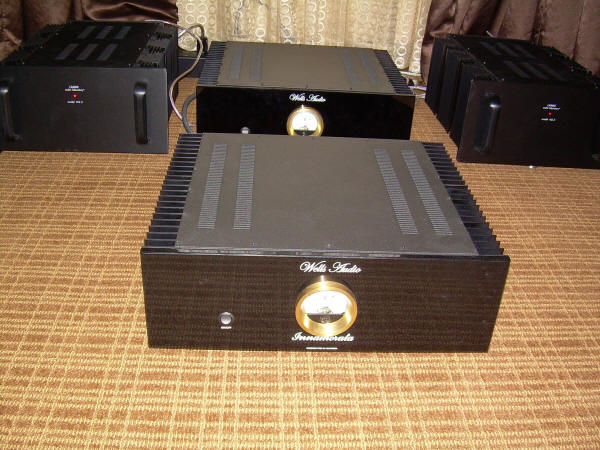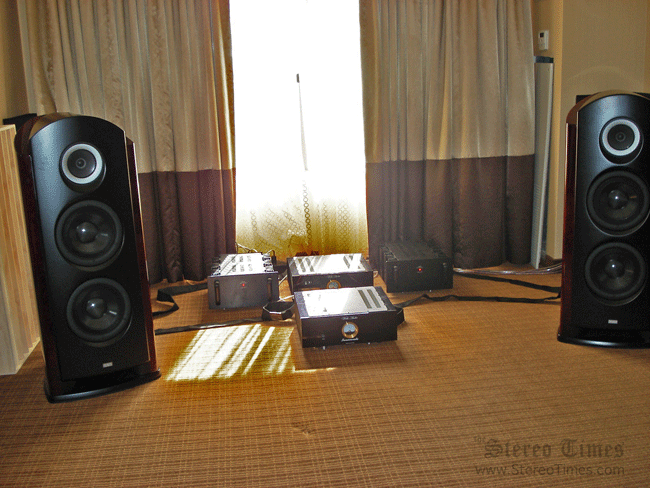- Thread Author
- #1
International Phonograph Incorporated (IPI) Room

Jonathan Horwich (IPI) is another local Chicago native. He is quite the visionary and has some very interesting plans for bringing his products to market in the future. Jonathon has a considerable reserve of master tapes recorded over the last 40 years. Artists include Bobby Bradford, John Carter, Wayne March, Claire Fisher and many more.
IPI has one simple goal: to record and produce the greatest jazz with the highest quality audio equipment and reproduction possible. IPI accomplishes this goal by copying the original recordings to 1/4 inch two track 15ips IEC (CCIR) 10.5 inch analog tape reels. They also have an expert mastering facility specializing in producing masters for analog or CD replication.
I don’t want to sound overly dramatic, but I could feel the passion and excitement when just entering this room. This is a unique company. IPI tapes and CDs are as good as it gets. I had a hard time getting out of my chair and moving on to the next suite. I could have stayed all day. A nice glass of 1961 Chateau Palmer Margaux would have persuaded me to do so – though none was on hand.
For this demonstration, the speakers used were the TAD Reference One. Amplifiers were the Lamn M2.2 monoblocks and Wells Audio Innamorato. The line level preamp and phono preamp were the Lamn L2 Reference and the Lamn LP2. The tape deck was the mighty United Audio Phase 11—check out the sexy picture below. The turntable was the Artesian Fidelity Achates Idler Drive fitted with a Reed 3P/12 arm and Pernambuco wand. The cartridge was a Van Den Hul Colibri XGM. Also on hand was a MSB Data CD IV player and a Meitner MA-1 DAC. All wire was Verastarr Grand Illusion. Master tapes were provided by IPI.
I love small jazz quartet recordings. When properly recorded and then properly reproduced, the system can disappear and you can approach the real thing. We have all heard the standard audiophile recordings that can make most systems sound great, but the musicians and music can sometimes underwhelm. IPI has taken it to another level of sound quality, but this time the music is timeless if not thrilling.
The sound in this room had me mesmerized. Reeds, horns and cymbals were life like. Speed, transparency and dynamics were some of the best I have ever heard at a show. All of this and also an immediate sense of musical purity and harmony. I can only wonder what this system might sound like in a reasonable room with reasonable acoustics.
A few things stood out for me that had me scratching my head and thinking about my recent reviews of some very expensive high end equipment.
The TAD Reference One is amazing. All the recent buzz for Magico and YG Acoustics speakers is well deserved. Finally, after years of slow but steady progress in the industry, we have speaker systems with dramatic and creative new designs that are producing music in ways that never seemed possible.
The TAD Reference One can compete with any of them. Again, we have a fantastic amount of razor sharp speed and transparency. The Reference Ones have an added dimension of warmth and musicality. Too much? What is correct? Only your ears and personal biases can lead you to what seems right. I would like to see some more reviews of these speakers as I think they are really one of the hidden gems available to the audiophile community.
The other product that got my attention was the Wells Audio Innamorata amplifier. 120 Watts push-pull magical musical bliss. It was fantastic when paired with the Reference One.
We rotated back and forth between the Innamorata and the Lamn M2.2 monoblocks. Both were outstanding but different. You can easily understand the price, popularity and respect for the Lamns. They seemed to have a sharper and more defined picture of the music. Imaging and sound stage were state of the art. Proper decay and reverberation provided a Technicolor look into the recording venue. There was also a sense of refinement that most amplifiers cannot deliver.
However, the Innamorato was something of a huge surprise. Plenty of inner speed and detail. Dynamic contrasts were delivered at levels very close to the best. Not as impressive as the Lamns on these measures, but again we have those subjective variables of warmth and musicality added in with the Innamorato. I reiterate, which is correct? Which is more appealing? Are we targeting neutrality or something else?
At $23,790 per pair retail, the Lamns do more than justify their price. At $6000 retail, the Innamorato might be considered a giant killer for those on a budget. From a price perspective this might seem like a mismatch, but for my ears, the Innamorato and Reference One combination should be at the top of your audition list if budget allows.

International Phonograph, Inc. Let me begin by telling you about a room that many other people kept telling me was the best sounding room that they heard (and I concur). It was the International Phonograph room which featured products from Artisan Fidelity, Wells Audio, Lamm Industries, United Home Audio and Verastarr cables.

Jonathan Horwich (IPI) is another local Chicago native. He is quite the visionary and has some very interesting plans for bringing his products to market in the future. Jonathon has a considerable reserve of master tapes recorded over the last 40 years. Artists include Bobby Bradford, John Carter, Wayne March, Claire Fisher and many more.
IPI has one simple goal: to record and produce the greatest jazz with the highest quality audio equipment and reproduction possible. IPI accomplishes this goal by copying the original recordings to 1/4 inch two track 15ips IEC (CCIR) 10.5 inch analog tape reels. They also have an expert mastering facility specializing in producing masters for analog or CD replication.
I don’t want to sound overly dramatic, but I could feel the passion and excitement when just entering this room. This is a unique company. IPI tapes and CDs are as good as it gets. I had a hard time getting out of my chair and moving on to the next suite. I could have stayed all day. A nice glass of 1961 Chateau Palmer Margaux would have persuaded me to do so – though none was on hand.
For this demonstration, the speakers used were the TAD Reference One. Amplifiers were the Lamn M2.2 monoblocks and Wells Audio Innamorato. The line level preamp and phono preamp were the Lamn L2 Reference and the Lamn LP2. The tape deck was the mighty United Audio Phase 11—check out the sexy picture below. The turntable was the Artesian Fidelity Achates Idler Drive fitted with a Reed 3P/12 arm and Pernambuco wand. The cartridge was a Van Den Hul Colibri XGM. Also on hand was a MSB Data CD IV player and a Meitner MA-1 DAC. All wire was Verastarr Grand Illusion. Master tapes were provided by IPI.
I love small jazz quartet recordings. When properly recorded and then properly reproduced, the system can disappear and you can approach the real thing. We have all heard the standard audiophile recordings that can make most systems sound great, but the musicians and music can sometimes underwhelm. IPI has taken it to another level of sound quality, but this time the music is timeless if not thrilling.
The sound in this room had me mesmerized. Reeds, horns and cymbals were life like. Speed, transparency and dynamics were some of the best I have ever heard at a show. All of this and also an immediate sense of musical purity and harmony. I can only wonder what this system might sound like in a reasonable room with reasonable acoustics.
A few things stood out for me that had me scratching my head and thinking about my recent reviews of some very expensive high end equipment.
The TAD Reference One is amazing. All the recent buzz for Magico and YG Acoustics speakers is well deserved. Finally, after years of slow but steady progress in the industry, we have speaker systems with dramatic and creative new designs that are producing music in ways that never seemed possible.
The TAD Reference One can compete with any of them. Again, we have a fantastic amount of razor sharp speed and transparency. The Reference Ones have an added dimension of warmth and musicality. Too much? What is correct? Only your ears and personal biases can lead you to what seems right. I would like to see some more reviews of these speakers as I think they are really one of the hidden gems available to the audiophile community.
The other product that got my attention was the Wells Audio Innamorata amplifier. 120 Watts push-pull magical musical bliss. It was fantastic when paired with the Reference One.
We rotated back and forth between the Innamorata and the Lamn M2.2 monoblocks. Both were outstanding but different. You can easily understand the price, popularity and respect for the Lamns. They seemed to have a sharper and more defined picture of the music. Imaging and sound stage were state of the art. Proper decay and reverberation provided a Technicolor look into the recording venue. There was also a sense of refinement that most amplifiers cannot deliver.
However, the Innamorato was something of a huge surprise. Plenty of inner speed and detail. Dynamic contrasts were delivered at levels very close to the best. Not as impressive as the Lamns on these measures, but again we have those subjective variables of warmth and musicality added in with the Innamorato. I reiterate, which is correct? Which is more appealing? Are we targeting neutrality or something else?
At $23,790 per pair retail, the Lamns do more than justify their price. At $6000 retail, the Innamorato might be considered a giant killer for those on a budget. From a price perspective this might seem like a mismatch, but for my ears, the Innamorato and Reference One combination should be at the top of your audition list if budget allows.

International Phonograph, Inc. Let me begin by telling you about a room that many other people kept telling me was the best sounding room that they heard (and I concur). It was the International Phonograph room which featured products from Artisan Fidelity, Wells Audio, Lamm Industries, United Home Audio and Verastarr cables.
